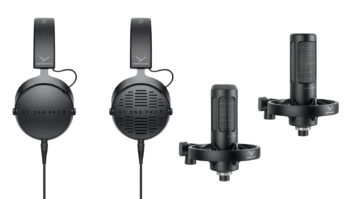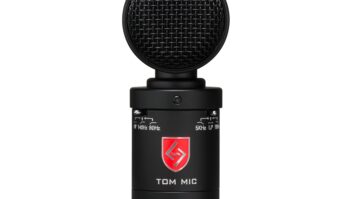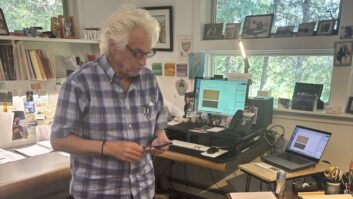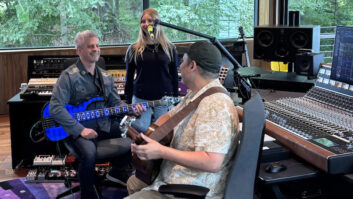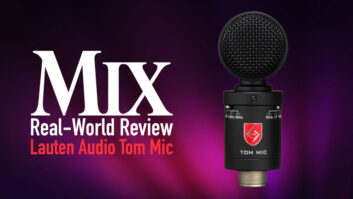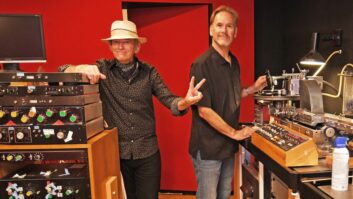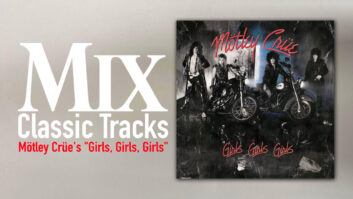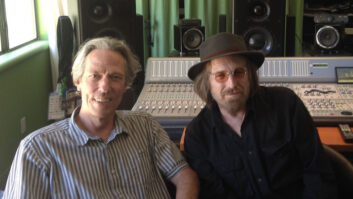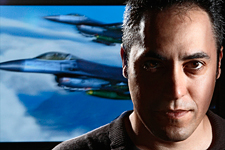
Composer and music producer Tom Salta (pictured), whose previous credits include the original score for Tom Clancy’s Ghost Recon: Advanced Warfighter (GRAW, which was nominated for an MTV Video Music Award) and the acclaimed sequel Tom Clancy’s Ghost Recon: Advanced Warfighter 2, has written and recorded the original music score for Tom Clancy’s H.A.W.X, the first air-combat game set in Clancy’s videogame universe. H.A.W.X was released earlier this month for the Xbox 360, PlayStation 3 and Windows-based PC formats.
Developed by Ubisoft Entertainment’s studio in Bucharest, Romania, Tom Clancy’s H.A.W.X offers an intense and authentic aerial combat experience by fully leveraging the benefits of the current-generation platforms. To emphasize the game’s cutting-edge technology, devastating firepower, and intense dogfights, Salta composed an adrenalized and emotionally charged hybrid score that blends his electronic music with a live orchestra. Salta first composed the entire game working mostly “in the box” in his project studio in West Norwalk, Conn., Persist Music. With his score complete, Salta went to New York City for two sessions at Legacy Recording Studios with orchestral ensembles that were comprised of musicians from the New York Philharmonic and Metropolitan Opera Orchestra. Salta then merged and edited all of the tracks and completed the final mixes in Persist Music.
Emil Gheorghe, producer of H.A.W.X, comments, “In Tom Clancy’s H.A.W.X we had to explore five emotional dimensions: the patriot, the life of a mercenary, betrayal, hopelessness and open war on U.S. soil. Tom Salta managed not only to tie all these elements together in an astoundingly rich and memorable score, but he also crafted an acoustical identity for our game to stand up in the midst of the Tom Clancy’s titles. Using orchestral arrangements, high-tech sounds and a mix of traditional instruments, he built an incredibly diverse soundtrack ranging from flavorful traditional themes to military tracks.”
To further explore Salta’s approach to scoring Tom Clancy’s H.A.W.X, I spoke with Salta by phone the day before he traveled to San Francisco to attend the 2009 Game Developers Conference.
How did this gig come about for you? Was it due to your relationship with Ubisoft?
Even though I had never worked with them [Ubisoft’s H.A.W.X development team in Bucharest, Romania] before, they knew of my name based on my work on the other Tom Clancy titles. They really wanted to preserve the established Tom Clancy sound from the previous games, so they enlisted people from the teams on those various games, and I happened just to be one of those people. When it comes to the Tom Clancy brand, of course, there’s a particular sound, look and feel to it, and so they really wanted to get the best [people from] all the previous games and create a new team for H.A.W.X based on that.
It makes sense to go for continuity in this series, since you already worked on those other Tom Clancy titles.
Absolutely. It was really great because the story line of H.A.W.X literally begins exactly where the story line of GRAW 2 ends; when I read that in the documentation, I immediately asked the [H.A.W.X] team if they would be open to the idea of referencing the style and the feel from the GRAW 2 theme on that first [H.A.W.X] mission, and they were very open to it. If you actually listen closely to the [first H.A.W.X] mission, you might hear the reference to the original GRAW theme, and then it evolves into the H.A.W.X theme. It literally connects the two universes together.
How do you approach an aerial combat game? Did this game plot make this game unique for you versus other projects you’ve worked on?
The flying aspect was the most different thing about H.A.W.X than the GRAW games, and really none of the music in GRAW—that particular style—would ever work with H.A.W.X, yet there had to be some kind of familiar feel to the music. So I had to walk a fine line there, and the biggest key difference that the team wanted to hear in H.A.W.X was [music that supports] the super high-tech nature of these modern planes and the aspect of speed—because no matter what you’re doing, you’re always going fast, and usually there’s a crisis or you’re rushing to get somewhere. Therefore, the vast majority of the cues had some element giving a sense of speed and urgency.
I assume that means mostly fast tempos, because often that’s what communicates urgency.
That’s correct—mostly fast tempos. But I wanted to look for as many breathers as possible after hearing all these fast-fast, full-on pieces. So sometimes I would do a half-time piece, but I would always have some kind of element clicking double-time, whether it be some little electronic sound or some little string line moving around. It would always give you the sense that something is moving fast but it might not always be full on or ultra-intense. I think we have a good variety in the score.

It sounds like music plays a large role in H.A.W.X, and that’s probably due to the nature of the aerial combat setting.
I knew that in a game like H.A.W.X, first of all, you probably wouldn’t hear much of the music [laughs] sometimes because of all the engine noise and the shooting and what have you. But I also knew that there would be a storyline to this and there would be certain requirements that they would want to portray emotionally. In certain parts of the game you’re going to feel powerful, heroic and on top of things; sometimes you’re going to feel threatened, sad or scared. But the visual aspect of the game really doesn’t change too much. You’re always flying the plane and you’re always shooting. You’re just in different environments and different locations battling different enemies. But the overall look is the same, so I think the music played an important role in portraying the emotional dimension. The music really had to give the game an emotional layer that would affect the player, depending on what they were listening to. When you play the game, you’ll notice that.
How did you begin the project? What guidelines and parameters were you given?
They gave me a script and a cue list, and on that cue list they gave me a lot of detailed descriptions of the kinds of emotions they wanted. For example, the cue list might have 10 battles and 20 mission intros, and it would often describe the location, particularly for the mission intros. But for the battles, I mean, this [stage of the project] was almost a year ago, so no one really knew which battle the music was going to be used for. So they covered the full emotional spectrum of all the kinds of music they would need based on the story, but not necessarily knowing when and where in the actual game it would be used. So in the most literal sense, I gave them building blocks of music that can be rearranged throughout the entire game to assemble the score based on their criteria. There would be different victory endings and different losing cues, and there would be continuity between all of them. But it had to be done in a way so there was enough variety and didn’t sound monotonous.
In creating these musical building blocks, do you have to be flexible with keys and tempos, depending on how things develop over time in the game?
That’s right. You don’t want to get yourself in a corner because you never quite know how they’re going to implement the music. You want to give them as much flexibility as possible. Sometimes they will take a piece of music that was meant to happen before another piece of music, but in the end it doesn’t turn out that way, so you have to think of these things as interchangeable cues and building blocks of music. I paid very close attention to the tempos and keys that I worked with so even when I modulated, the music sounded very natural going from one to key to another, up or down, and including the tempos as well.
From the beginning, the H.A.W.X audio team wanted a hybrid electronic and live orchestral score—which is the type of score you composed for Ubisoft’s Red Steel (for more on Red Steel, read “Capturing Taiko Drums for Ubisoft’s Red Steel” from Mix’s March 2007 issue).
Right. They did their own internal testing with other music, and they all agreed that the score should have both orchestral and electronic elements in it, and that means synths and modern drums. And that’s good for me. I’m very comfortable working in that way. I sometimes use the term “orchestronic.” I feel very comfortable working with both of those styles, and it really enables me to use whatever instrument I want to get the effect that I’m going for, so I’m not just limited to the traditional orchestral palette. If I want to add extra intensity, I can reach into any of my synths or drums, or anything you can imagine—effects, distortion—whatever needs to happen. I really don’t concern myself with “the rules” all the time.

Tom Salta in his project studio, Persist Music
How did you use your studio for this project?
The way I put the H.A.W.X score was put together was that I did the entire thing first in my own studio. That means everything: the fake orchestra and every single instrument. Once the cues were fully approved and done, which sounded pretty good the way they were, we were then able to secure additional live budget—not as much as I would have hoped, but enough. It was 60 minutes of music and I didn’t have enough money to do two full days with a large orchestra. I figured out, [along] with my orchestrator, that we would be able to do one full day with all the people we wanted. On the second day we had to cut it down to half, so we prioritized the cues and put all of the cues that required the big orchestra on the first day, and the remainder on the second. It worked out really well. The cues already sounded very full and big and when you put the full orchestra on top of that, then it’s just massive.
So you record the full orchestra on top of your full-sounding tracks? Do you ever need to take elements out of your electronic score to make room for the orchestra?
Well, most often I’m not taking things out since I know what the orchestra will do. Usually [the orchestra] is an additional layer and I might remove certain fake orchestral parts.
Your studio has a dual quad core Mac Pro G5 running Apple Logic Pro 8. Which soft synths and virtual instruments did you use for this project?
I’ve always loved Spectrasonics’ stuff, and currently, that mostly means Omnisphere and RMX. Native Instruments also has a wonderful suite of software that I use, including Kontakt, Absynth and FM8.
Was Logic’s EXS24 your primary sampler?
Yeah. I try to use that as much as possible just because it’s so CPU and RAM-efficient being that it’s the native sampler that Logic uses.
Did you do any custom sampling?
Sometimes. For H.A.W.X I spent a lot of time creating unique rhythm beds, generating my own combinations of textures that I would use to create the backing rhythms for a lot of these cues. I wanted to have the right blend of modern and traditional percussive elements, so I focused quite a bit on that.
Did you do any audio recording in your studio?
In my personal studio I recorded additional solo vocalists for certain geographical areas in the game, which required certain ethnic styles. We also recorded some guitar work here as well. A good number of the soloists were actually recorded remotely from other studios—gotta love the Internet!
So you completed everything at home and brought all of these files into Legacy Studios for those two days.
That’s correct. I did all the prep here [in Persist Music] and then we prepared the Pro Tools sessions for Legacy. That’s where we recorded the orchestra. I didn’t want to deal with 40 or 50 tracks, so we actually mixed at Legacy to bounce it down into smaller groups of stems, and then I would lay those into my sessions and they all synched up. I did the final mix here and then sent the stems over to Ubisoft for any additional mixing or variations they wanted to do later.
Considering that you do most of your production work “in the box,” do you have any favorite plug-ins?
A friend of mine turned me on to Sonnox Oxford Plug-Ins a while ago, and when I had chance to listen, they jumped out at me. I really liked the Inflator, Dynamics and EQ. I tend to do things very instinctively and try not to lock myself into patterns. Because of the nature of the work I do and my desire to stay fresh, I give [the Oxford EQ] a chance on everything. I’ll often put the EQ on the Master Bus. The EQ in particular just had a very sweet sound to it. It’s a subtle quality that my ears, after so many years, just know. If I take the high end and just tweak it up a little bit, you get a certain quality to the sparkle that reminds me of very high-end hardware EQs.

Legacy Recording Studios hosted two sessions with orchestral ensembles comprised of musicians from the New York Philharmonic and Metropolitan Opera Orchestra.
Do you remember the setup at Legacy for the orchestra sessions?
I remember the engineer [Jason Stasium] placed mics all over the room and of course [used] some close miking. I don’t remember the specifics about those particular mics—but [they were] much of what you would expect. The most notable thing I remember is that I deliberately rented some vintage Neumann M 50 microphones for the orchestra, which we used in the Decca Tree—they sounded fantastic.

Tom Salta at Legacy Recording Studios in New York City
How does all this music, comprised of your electronic tracks plus the orchestra, translate on game playback systems—the PCs and the PlayStation, and so on?
First of all, H.A.W.X is a next-generation game, meaning it’s going to be played on systems like Xbox 360, PC, PS3, which can put out full high-res audio. There are no limitations in terms of sonic range on these systems. The only consideration that you really have to keep in mind is that your mix is will sound good on a variety of sound systems that people would have in their homes. They’re not going to always have high-end systems, but often they’re pretty decent. So that’s the consideration that I always keep in mind when I mix. Those 15 years prior to games that I had in the music business, mixing and producing records comes in very handy! [Laughs]
Of course it’s then up to Ubisoft’s audio team in Bucharest to implement the music with the game sounds.
Right. On certain projects I often don’t know how the music is going to be used and I don’t know the way it’s going to sound. So I kind of sit back and anxiously wait until the game comes out to see what happened. You can take a good score and kill it if it’s implemented badly—you really can! But I’m playing [H.A.W.X] now and it seems to be flowing very well…when you can hear it, of course. [Laughs]
Matt Gallagher is an assistant editor at Mix.
For more information on Tom Salta’s studio, read “Project Studio: Persist Music” from Mix’s February 2008 issue.
Visit Tom Salta’s Website at www.tomsalta.com, and watch Salta’s video interview about his work behind the scenes on the H.A.W.X game.
To preview samples of Salta’s music for H.A.W.X, visit the game’s official Website at http://hawxgame.com/.
